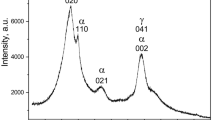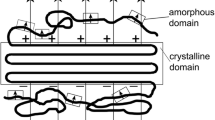Abstract
Vinylidene fluoride (VDF)/tetrafluoroethylene (TFE) 94/6 copolymer films obtained by low-temperature crystallization from acetone solution and by melt-crystallization under high pressure were studied. As shown in the X-ray diffraction patterns, β- and γ- phases coexist in the sample crystallized from a solution. At melt-crystallization, a number of γ-crystals decrease and spherulitic supramolecular structure is formed. It is accompanied by a decrease of the amorphous phase density in the intra- and inter-spherulite regions, which leads to an increase in the glass transition temperature. Differential scanning calorimetry data indicate a smaller fraction of the amorphous phase for the sample crystallized from the melt. At the same time, the relaxation strength of the mobility in the amorphous phase in this sample is higher. This contradiction is explained by the increased ratio of isomers in planar zigzag conformation, as shown by IR spectroscopy.











Similar content being viewed by others
Data availability
The datasets generated during and/or analyzed during the current study are available from the corresponding author on reasonable request.
References
Wang ТТ, Herbert JM, Glass AM (eds) (1988) The application of ferroelectric polymers. Blackie, Glasgow
Nalva HS (ed) (1995) Ferroelectric polymers – chemistry, physics and applications. Marcel Dekker Inc, New York
Kochervinskii VV (1999) Ferroelectricity of polymers based on vinylidene fluoride. Russ Chem Rev 68:821–857. https://doi.org/10.1070/RC1999v068n10ABEH000446
Kawai H (1969) The piezoelectricity of poly (vinylidene fluoride). Jpn J Appl Phys 8:975–976. https://doi.org/10.1143/JJAP.8.975
Bergman JG, McFee JH, Crane GR (1971) Pyroelectricity and optical second harmonic generation in polyvinylidene fluoride films. Appl Phys Letts 18:203–205. https://doi.org/10.1063/1.1653624
Lewin PA (1981) Miniature piezoelectric polymer ultrasonic hydrophone probes. Ultrasonics 19:213–216. https://doi.org/10.1016/0041-624X(81)90005-6
Granz B (1989) PVDF hydrophone for the measurement of shock waves (lithotripsy). IEEE Trans Electr Insul 24:499–502. https://doi.org/10.1109/14.30896
Hughes WJ (1992) Underwater polyvinylidenefluoride PVDF acoustic sensors. J Acoust Soc Am 91:2335. https://doi.org/10.1121/1.403503
Markose S, Patange S, Raja S, Jain A, Elias B. (2013) Experimental study on dimension effect of PVDF film on energy harvesting. IJAREEIE (Special Issue ICETES 2013):270-278
Latour M, Murphy PV (1981) Application of PVF2 transducers as piezoelectric vibrators for marine fouling prevention. Ferroelectrics 32:33–37. https://doi.org/10.1080/00150198108238670
Zhu L, Wang Q (2012) Novel ferroelectric polymers for high energy density and low loss dielectrics. Macromol. 45:2937−2954. https://doi.org/10.1021/ma2024057
Zhou R, Liu W, Kong J, Zhou D, Ding G, Leong YW, Pallathadka PK, Lu X (2014) Chemically cross-linked ultrathin electrospun poly(vinylidenefluoride-co-hexafluoropropylene) nanofibrous mats as ionic liquid host in electrochromic devices. Polymer 55:1520–1526. https://doi.org/10.1016/j.polymer.2014.01.047
Kochervinskii VV (2006) Mechanism of polarization and piezoelectric behavior in crystalline ferroelectric polymers from the standpoint of propagation of soliton waves. Polym Sci Ser C 48:38–57. https://doi.org/10.1134/S1811238206010036
Kochervinskii VV (2003) Piezoelectricity in crystalline ferroelectric polymers: polyvinylidene fluoride and its copolymers (a review). Crystallogr Reports 48:649–675. https://doi.org/10.1134/1.1595194
Kochervinskii VV (2003) Structural aspects of piezoelectricity in crystallizable ferroelectric polymers: vinylidene fluoride homopolymer and copolymers. Polym Sci Ser B 45:326–360
Kochervinskii VV (2009) New electrostriction materials based on organic polymers: a review. Crystallog Rep 54:1146–1171. https://doi.org/10.1134/S1063774509070062
Kochervinskii VV, Glukhov VA, Sokolov VG, Romadin VF, Murasheva EM, Ovchinnikov YK, Lokshin BV (1988) Microstructure and crystallization isotropic films copolymers of the vinylidene fluoride – tetrafluro-ethylene. Polym Sci USSR 30:2100–2108. https://doi.org/10.1016/0032-3950(88)90067-6
Warren BE (1990) X-ray diffraction. Dover, New York
Mogilevskii LY, Dembo AT, Svergun DI, Feigin LA (1984) Small-angle X-ray diffractometer with single-axis detector. Kristallografiya (in Russian) 29:587–591
Feigin LA, Svergun DI (1987) Structure analysis by small-angle X-ray and neutron scattering. Plenum Press, New York
Guinier A, Fournet G (1955) Small-angle scattering of X-rays. John Wiley and Sons, New York
Kochervinskii VV (1996) The structure and properties of block poly(vinylidene fluoride) and systems based on it. Russ Chem Rev 65:865–913. https://doi.org/10.1070/RC1996v065n10ABEH000328
Li Y, Tang S, Pan M-W, Zhu L, Zhong G-J, Li Z-M (2015) Polymorphic extended-chain and folded-chain crystals in poly(vinylidene fluoride) achieved by combination of high pressure and ion-dipole interaction. Macromol. 44:8565–8573. https://doi.org/10.1021/acs.macromol.5b01895
Kochervinskii VV, Kozlova NV, Khnykov AY, Shcherbina MA, Sulyanov SN, Dembo KA (2010) Features of structure formation and electrophysical properties of poly(vinylidene fluoride) crystalline ferroelectric polymers. J Appl Polym Sci 116:695–707. https://doi.org/10.1002/app.31044
Kochervinskii V, Kozlova N, Malyshkina I, Astakhov V (2018) Structural aspects of the high-temperature space charge relaxation in ferroelectric VDF/TFE 94/6 copolymer. Ferroelectrics 531:1–21. https://doi.org/10.1080/00150193.2018.1497407
Wilkes GL, Stein RS (1975) Physicochemical approaches to the measurement of molecular anisotropy. In: Ward IM (ed) Structure and properties of oriented polymers. Halsted, Wiley, New York, pp 44–141
Kochervinskii VV, Malyshkina IA, Gradova MA, Kozlova NV, Shmakova NA, Buzin MI, Korlyukov AA, Bedin SA (2019) On the features of cooperative mobility in the amorphous phase of ferroelectric polymers. Colloid Polym Sci 297:513–520. https://doi.org/10.1007/s00396-019-04478-6
Kolb R, Wutz C, Stribeck N, von Krosigk G, Riekel C (2001) Invesigation of secondary crystallization of polymers by means of microbeam X-ray scattering. Polymer 42:5257–5266. https://doi.org/10.1016/S0032-3861(00)00920-4
Neidhofer M, Beaume F, Ibos L, Bernes A, Lacabanne C (2004) Structural evolution of PVDF during storage or annealing. Polymer 45:1679–1688. https://doi.org/10.1016/j.polymer.2003.12.066
Nakagava K, Ishida Y (1973) Annealing effects in poly(viny1idene fluoride) as revealed by specific volume measurements, differential scanning calorimetry, and electron microscopy. J Polym Sci: Polym Phys Ed 11:2153–2171. https://doi.org/10.1002/pol.1973.180111107
Ma W, Yuan H, Wang X (2014) The effect of chain structures on the crystallization behavior and membrane formation of poly(vinylidene fluoride) copolymers. Membranes 4:243–256. https://doi.org/10.3390/membranes4020243
Sasabe H, Saito S, Asahina M, Kakutani H (1969) Dielectric relaxations in poly (vinylidene fluoride). J Polym Sci A-2: Polym Phys 7:1405–1414. https://doi.org/10.1002/pol.1969.160070810
Koizumi N, Yano S, Tsunashima K (1969) Dielectric relaxation of poly(vinylidenefluoride). J Polym Sci Part B: Polym Lett 7:59–64. https://doi.org/10.1002/pol.1969.110070113
Nakagawa K, Ishida Y (1973) Dielectric relaxations and molecular motions in poly(vinyidene fluoride) with crystal form II. J Polym Sci Polym Phys Ed 11:1503–1533. https://doi.org/10.1002/pol.1973.180110804
Yano S, Tadano K, Aoki K, Koizumi N (1974) Alternating-current ionic conduction and dielectric relaxation of poly(viny1idene fluoride) at high temperatures. J Polym Sci Polym Phys Ed 12:1875–1887. https://doi.org/10.1002/pol.1974.180120911
Vogel H (1921) The law of relation between the viscosity of liquids and the temperature. Phys Z 22:645–646
Fulcher GS (1925) Analysis of recent measurements of viscosity of glasses. J Am Ceram Soc 8:789–794. https://doi.org/10.1111/j.1151-2916.1925.tb18582.x
Böhmer R, Ngai KL, Angell CA, Plazek DJ (1993) Nonexponential relaxations in strong and fragile glass formers. J Chem Phys 99:4201–4209. https://doi.org/10.1063/1.466117
Macedo PB, Moynihan CT, Bose R (1972) The long time aspects of this correlation function, which are obtainable by bridge techniques at temperatures approaching the glass transition. Phys Chem Glass 13:171–179
Richert R (2002) The modulus of dielectric and conductive materials and its modification by high electric fields. J Non-Cryst Sol 305:29–39. https://doi.org/10.1016/S0022-3093(02)01085-2
Funding
The work was supported by the Russian Foundation for Basic Research (RFBR 18-03-00493).
Author information
Authors and Affiliations
Contributions
All authors contributed to the study conception and design. Material preparation, data collection, and analysis were performed by V.V. Kochervniskii, V.A. Astakhov, S.A. Bedin, I.A. Malyshkina, N.A. Shmakova, A.A. Korlyukov, M.I. Buzin, and V.V. Volkov. The first draft of the manuscript was written by V.V. Kochervniskii and all authors commented on previous versions of the manuscript. All authors read and approved the final manuscript.
Corresponding author
Ethics declarations
Conflict of interest
The authors declare that they have no conflict of interest.
Additional information
Publisher’s note
Springer Nature remains neutral with regard to jurisdictional claims in published maps and institutional affiliations.
Rights and permissions
About this article
Cite this article
Kochervniskii, V.V., Astakhov, V.A., Bedin, S.A. et al. Peculiarities of structure and dielectric relaxation in ferroelectric vinylidene fluoride-tetrafluoroethylene copolymer at different crystallization conditions. Colloid Polym Sci 298, 1169–1178 (2020). https://doi.org/10.1007/s00396-020-04691-8
Received:
Revised:
Accepted:
Published:
Issue Date:
DOI: https://doi.org/10.1007/s00396-020-04691-8




